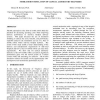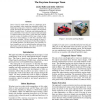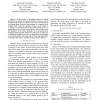AR
2008
14 years 29 days ago
2008
Recently, Linear Temporal Logic (LTL) has been successfully applied to high-level task and motion planning problems for mobile robots. One of the main attributes of LTL is its clo...
AROBOTS
2010
14 years 29 days ago
2010
In this paper we show how non
CCIA
2009
Springer
14 years 1 months ago
2009
Springer
General object recognition in mobile robots is of primary importance in order to enhance the representation of the environment that robots will use for their reasoning processes. T...
WSC
1998
14 years 2 months ago
1998
Flexible automation in the form of mobile robots holds the potential for decreasing operating costs while improving delivery performance in mid-size hospital delivery systems. Thi...
DAGSTUHL
1998
14 years 2 months ago
1998
Localization is one of the fundamental problems in mobile robotics. Without knowledge about their position mobile robots cannot e ciently carry out their tasks. In this paper we pr...
AAAI
2000
14 years 2 months ago
2000
Self-localisation is an essential competence for mobile robot navigation. Due to the fundamental unreliability of dead reckoning, a robot must depend on its perception of external...
AAAI
2006
14 years 2 months ago
2006
Stereo vision for small mobile robots is a challenging problem, particularly when employing embedded systems with limited processing power. However, it holds the promise of greatl...
RSS
2007
14 years 2 months ago
2007
— A simple approach for mobile robots to exploit multipath fading in order to improve received radio signal strength (RSS), is presented. The strategy is to sample the RSS at dis...
RIVF
2007
14 years 2 months ago
2007
— This paper is at the crossroad of Cognitive Psychology and AI Robotics. It reports a cross-disciplinary project concerned about implementing human heuristics within autonomous ...
MVA
2007
14 years 2 months ago
2007
— In this paper, a modeling method to handle furniture is proposed. In real environment, there is a lot of furniture such as drawer, cabinet and so on. If mobile robots can handl...



